Parasaurolophus was an herbivorous dinosaur that lived 76-74 million years ago during the Late Cretaceous period. It’s notable for its unusual head crest that kept paleontologists guessing for years. This article will uncover its purpose. Meet parasaurolophus — the dinosaur with a head crest.
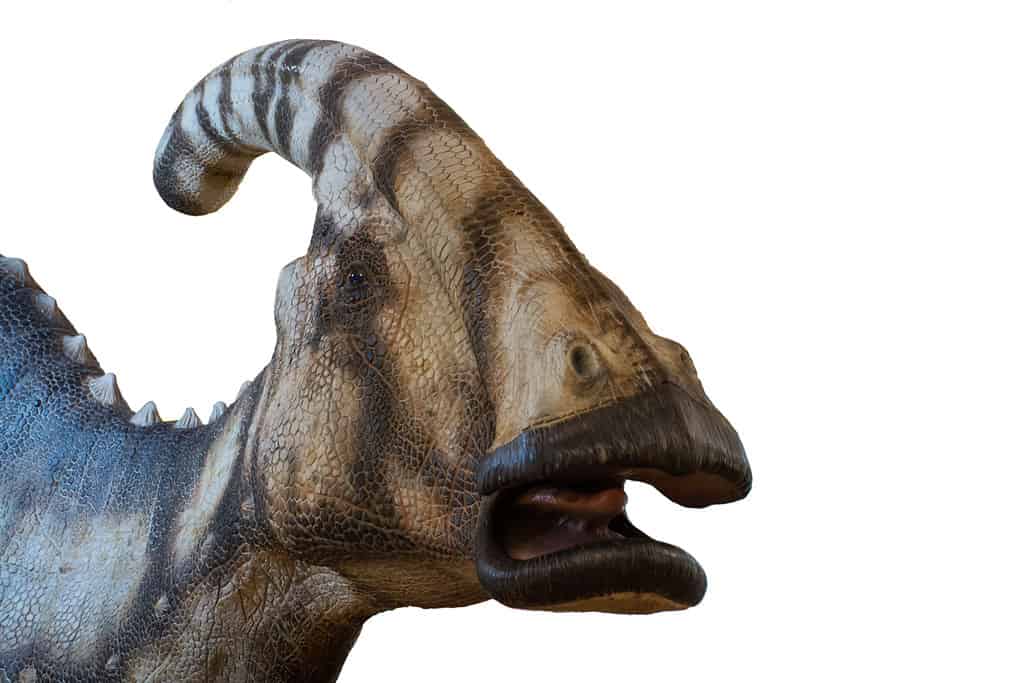
Parasaurolophus’s distinctive head crest grew from its nasal cavity to the back of the skull and was 5–7 feet long!
©Noiel/Shutterstock.com
What Did Parasaurolophus Head Crest Look Like?
Parasaurolophus’s distinctive head crest, called a cranial crest, was narrow and backward curving. It grew from its nasal cavity to the back of the skull.
Premaxilla and nasal bones formed the head crest. It was hollow with tubes that led from a nostril to the crest’s end, then back down the crest, and into the skull.
Recent computer modeling has reconstructed a parasaurolophus’s head crest using fossilized remains, and now experts are certain they know what functions the crest performed.
What Was It For?
Parasaurolophus used its head crest to make noise. Computer models show that such a construction would emit a loud honking sound.
The longer a crest was, the lower the noise it could produce. In modern animals, loud noises like this warn herd members of danger and communicate with others, so it’s likely the parasaurolophus’s crest did exactly that.
Although noise was a parasaurolophus crest’s primary function, experts think it also had other important functions.
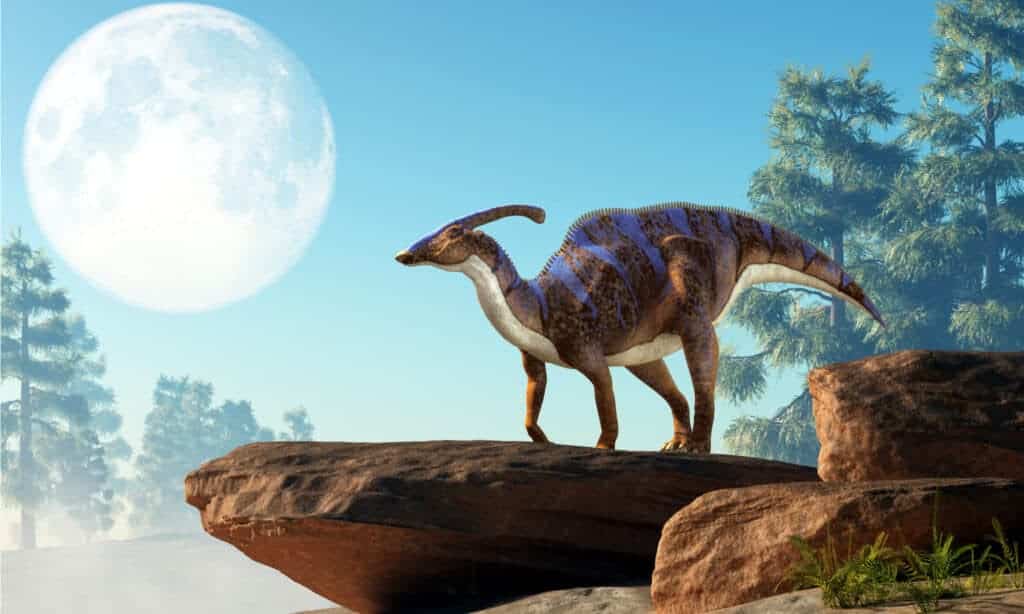
Communication was a parasaurolophus head crest’s primary function. Computer modeling indicates it made a honking noise.
©iStock.com/Daniel Eskridge
Temperature regulation
It’s unlikely parasaurolophus had warm blood. Cold-blooded dinosaurs depended on heat. Its crest created a large surface area capable of soaking up sunlight and warmth during the day and storing it like a heater. At night or during cold spells, its heat might dissipate and keep parasaurolophus in a constant warm state. Conversely, during very hot spells, it may help dissipate too much warmth to keep the animal cool.
Identification
Another potential crest use is identification. Like modern-day deer or cattle, each parasaurolophus would be endowed with a slightly different shape, size, or color variation crest. This would help herd members recognize one another and keep the herd safe from intruders.
Mating Display
Experts also suggest (although there’s no proof yet) that a male parasaurolophus might have displayed a larger, more extravagant crest to attract females. This sort of display is common in modern-day animals, such as male peacocks with disco-ball tail displays, mudskipper males jumping as high as possible, and sand lizards turning from dull brown to bright, vivid green to impress females.
Historical Theories
William Parks first discovered parasaurolophus in Alberta, Canada, in 1922. Paleontologists of the time suggested some rather bizarre ideas to explain the never-seen-before crest.
- Many thought it was a breathing tube, a bit like a snorkel, that enabled this dinosaur to spend time underwater.
- Others believed it was a weapon used to ram into predators or competitors, just like Pachycephalosaurus.
- Some paleontologists, without any evidence at all, suggested specialized nerve endings covered the crest and boosted herbivorous parasaurolophus’s plant-sniffing ability.
- An out-there theory put forward by Martin Wilfarth suggested the crest housed a proboscis similar to an elephant’s trunk. This idea was dismissed because the “trunk” would point backward.
- And a final historical theory put forward suggested the crest housed glands capable of expelling excess salt. Parasaurolophus lived near an inland sea, and some marine creatures have glands that expel salt.
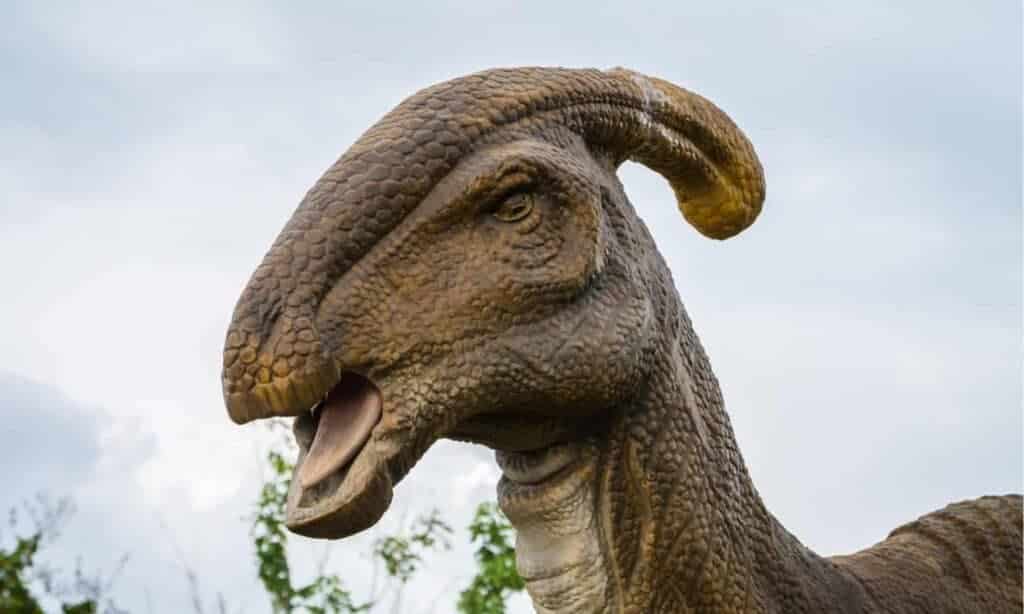
Parasaurolophus crests may also have played a part in the identification and mating displays.
©YuRi Photolife/Shutterstock.com
Did Baby Parasaurolophus Have a Head Crest?
Baby dinosaur fossils are rare, but in this case, we’re lucky.
A young parasaurolophus named “Joe” by its finders was uncovered in Utah. He died at one year old, 74 million ago.
His fossilized remains provide enough evidence to answer the question simply. No, baby parasaurolophus did not have a head crest. They did, however, have a bump in the same spot. Experts believe Joe’s head bump would eventually mature into a crest.
Species Overview
Parasaurolophus is pronounced para-saw-rol-off-us, and it means “like saurolophus,” another dinosaur that paleontologists of the time thought to be a close relative. These hadrosaurs roamed the modern-day United States and Canada.
Parasaurolophus: Sub-Species
There are three parasaurolophus subspecies, each with a different head crest.
P. walker: First discovered and therefore the holotype. Its crest is simple and straight and has a simplified internal structure to its subspecies.
P. tubicen: The largest species that roamed New Mexico. Three fossilized remains in the Kirtland Formation. Its crest had a more complex interior and was longer and straighter than other species.
P. cyrtocristatus: Found in Utah and New Mexico, it’s the smallest parasaurolophus species with the curviest crest. Some experts argue this is a female specimen due to its size and crest differences.
Parasaurolophus: Diet
Herbivorous parasaurolophus ate vegetation, pinching off tough ferns, conifer twigs, tree bark, and shrubs with its narrow beak. This tough vegetation took some chewing, but parasaurolophus used hundreds of small teeth to grind foliage up into a soft mass. Experts think they would have spent most of their time grazing, much like today’s cattle or elephant herds.
Throughout its life, a parasaurolophus’s front teeth eroded under constant friction, but its back teeth amazingly moved forward to replace them. Experts believe this happened across a dinosaur’s lifespan.
When and Where Did Parasaurolophus Live?
Parasaurolophus lived 76-74 million years ago in the Late Cretaceous period. Their fossilized remains are in Canada and the U.S., specifically Alberta, Utah, Arizona, and New Mexico.
Parasaurolophus: Appearance
Parasaurolophus was a medium-sized herbivore. Its adult length could reach 33 feet from nose to tail, and it weighed up to 7,716 lbs, that’s the same as a Rolls Royce Phantom. Its distinctive crest measured five feet long, almost exactly the same length as its skull. Interestingly, the subspecies P. tubican’s head was the largest. It measured over 6.7 feet long.
Like most ornithopods, parasaurolophus walked on four legs but could run from predators and reach up to grab overhanging vegetation on two feet. Paleontologists don’t know what color parasaurolophus was, but William Parks, who discovered the first fossilized parasaurolophus, recorded a skin patch of small non-overlapped scales.
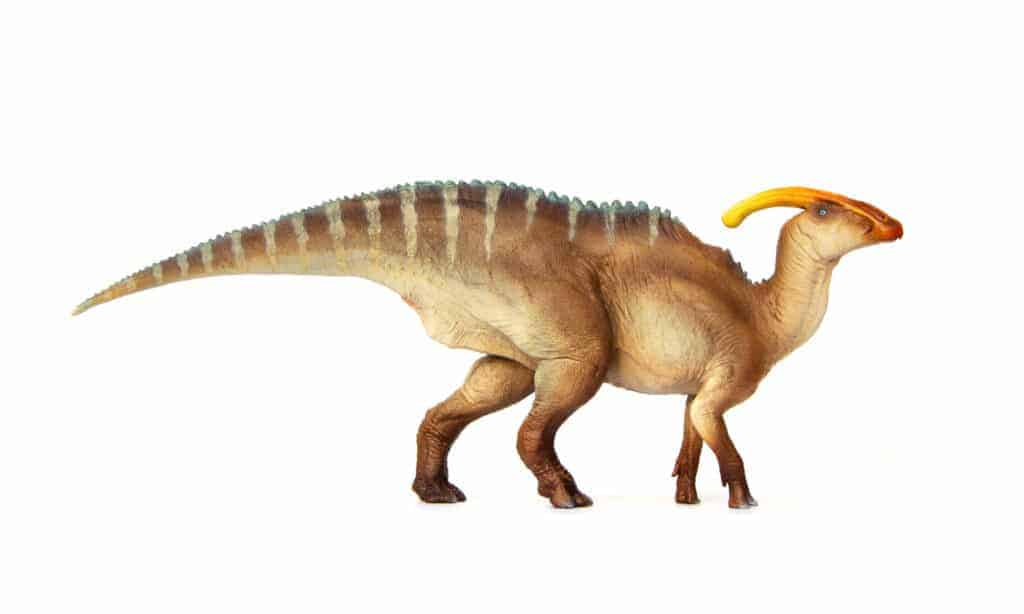
Experts don’t know the head crest color, but fossils indicate parasaurolophus skin was formed from small, non-overlapping scales.
©Ton Bangkeaw/Shutterstock.com
Parasaurolophus: Reproduction
Parasaurolophus was an egg layer. It built a nest and laid eggs that hatched into tiny versions of the adult. Experts don’t know if parents nurtured eggs like birds or left them to hatch like snakes.
Parasaurolophus: Habitat
Most likely, parasaurolophus lived in forests and woods with plenty of vegetation for grazing and hiding their ground-based eggs.
Fossilized parasaurolophus dinosaurs are found between the Rocky Mountains and an inland sea that no longer exists. At this point in time, the area was swampy with woods, and some experts think they actually lived in the drier uplands, and unfortunate individuals met a sticky end in the swamps.
What Predators Did Parasaurolophus Have?
Vegetarian parasaurolophus was a prey animal for carnivores of the Late Cretaceous. Contemporary meat-eating dinosaurs included:
- Tyrannosaurs
- Albertosaurus
- Gorgosaurus
- Daspletosaurus
- Bistahieversor
- Teratophoneus
- Troodon
Other Dinosaurs With Crests
Parasaurolophus’s head crest isn’t the only ancient crest gear dinosaurs wear. Here are a few others:
Coryraptor
This bird-like raptor dinosaur lived in modern-day China in the Cretaceous period. It stood 5.5 feet tall on two legs (like an ostrich) and carried a large crest on its head.
Dilophosaurus
Famous for killing Dennis Nedry in Jurassic Park, dilophosaurus lived in the early Jurassic era around 195 million years ago. It was a fearsome predator and one of modern-day North America’s largest predators. It stood six feet tall and ran at around 30 mph. Dilophosaurs had two thin, fragile crests atop their head.
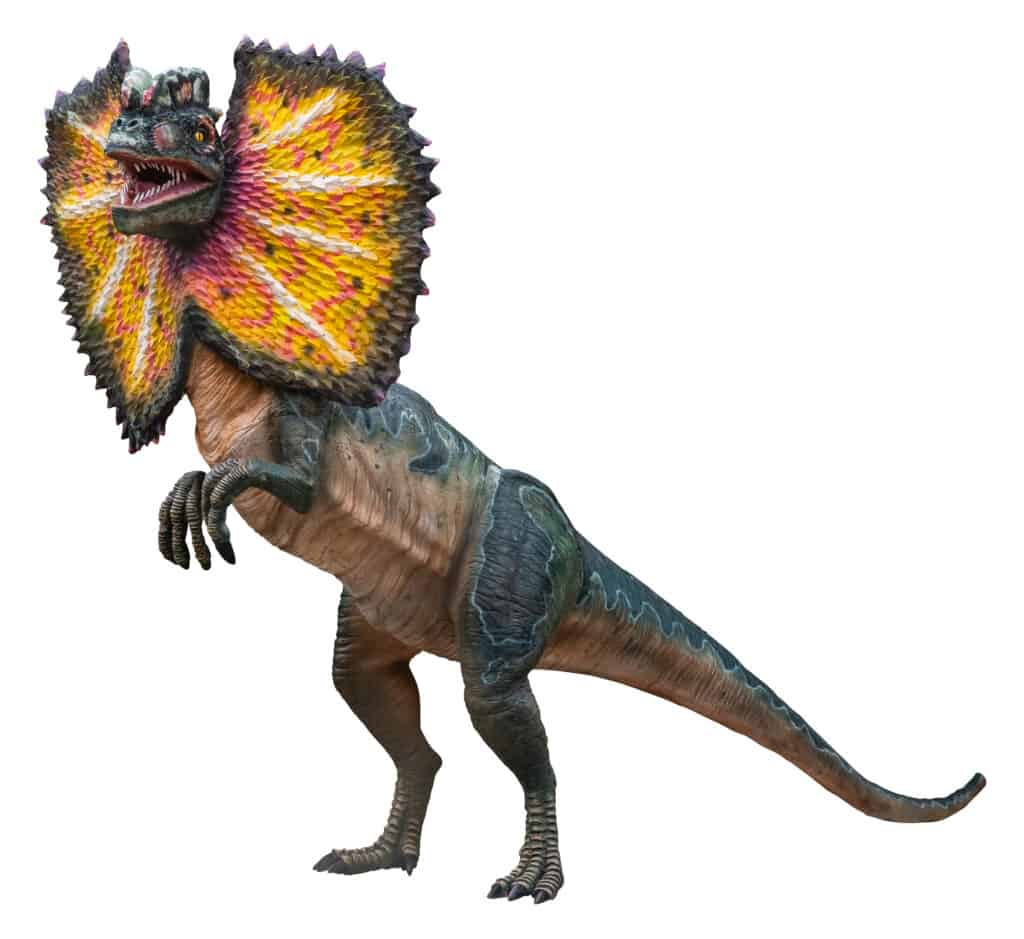
Dilophosaurus dinosaurs had two delicate head crests.
©YuRi Photolife/Shutterstock.com
Monolophosaurus
A Jurassic era 16 feet tall, 1,000 lbs carnivore that existed when the asteroid hit Earth, this mega predator lived in modern-day China and carried a large crest on its nose.
Spinosaurus
This Cretaceous-age dinosaur lived in modern-day North America alongside Tyrannosaurus Rex. It stood 59 feet high with 12-inch-long teeth and preyed on both land and water.
Spinosaurus had a large crest on its back that paleontologists call a “sail” and a small crest on its nose.
Parasaurolophus – What the Crest on Its Head Was Actually For
Hadrosaur parasaurolophus was an herbivore from the Late Cretaceous period best known for its large crested head.
Over the past 100 years, paleontologists have theorized about the crest’s function. Suggestions included a snorkel, excess salt remover, attachment for a proboscis, a weapon, and a plant-sniffing-out enhancer. However, thanks to modern computer modeling, experts now think communication is its main function.
CGI models indicate the crest’s shape and size would produce a honking sound capable of warning against predators and communicating with the herd. Secondary functions may include temperature regulation and mating displays.
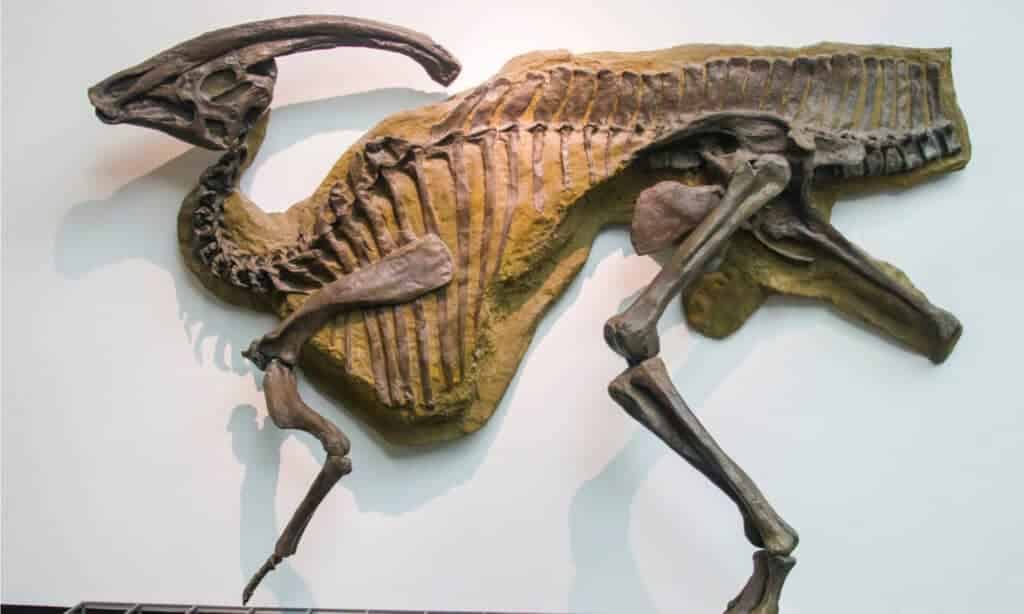
Seventeen partial parasaurolophus skeletons have been uncovered in North America and Canada.
©Danny Ye/Shutterstock.com
The photo featured at the top of this post is © Daniel Eskridge/Shutterstock.com
Thank you for reading! Have some feedback for us? Contact the AZ Animals editorial team.






